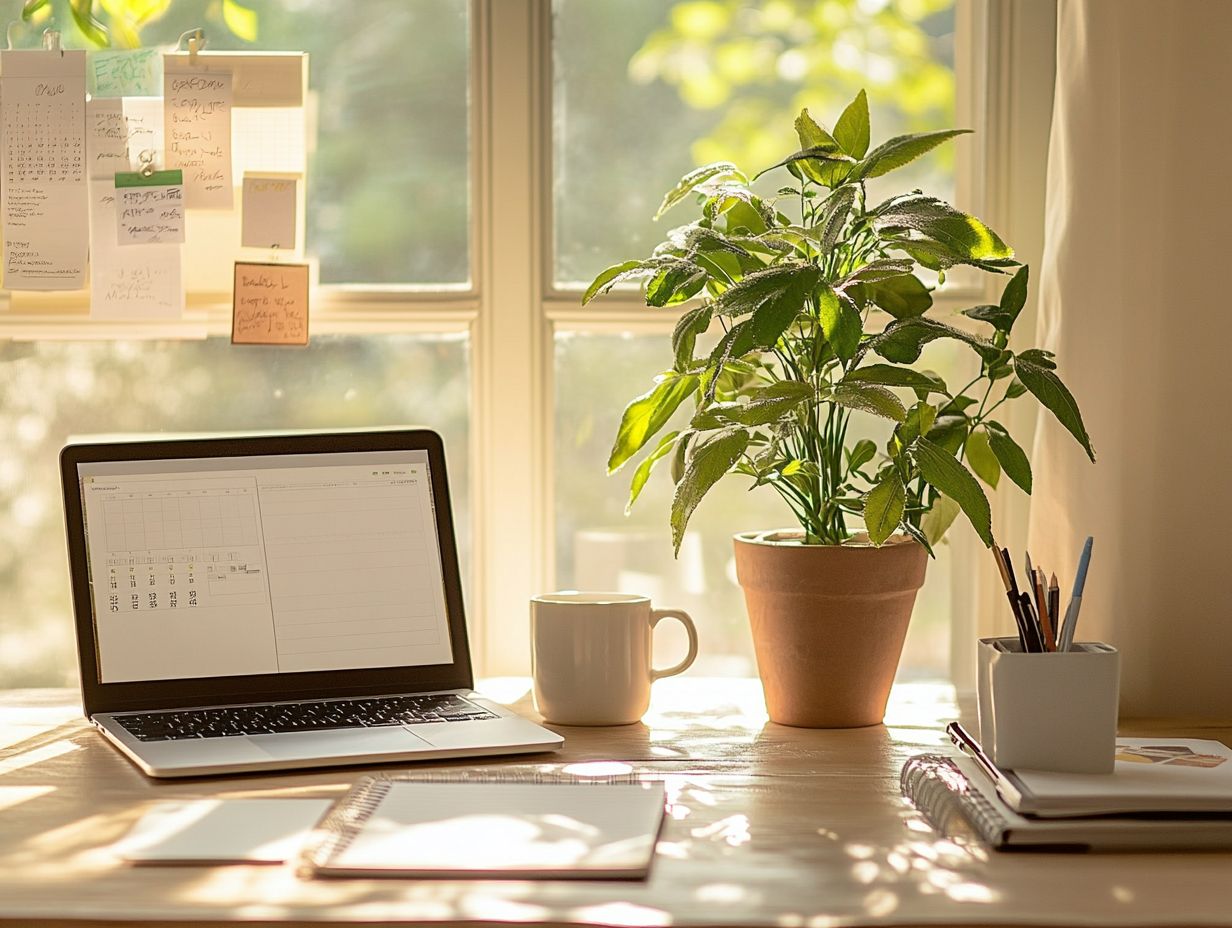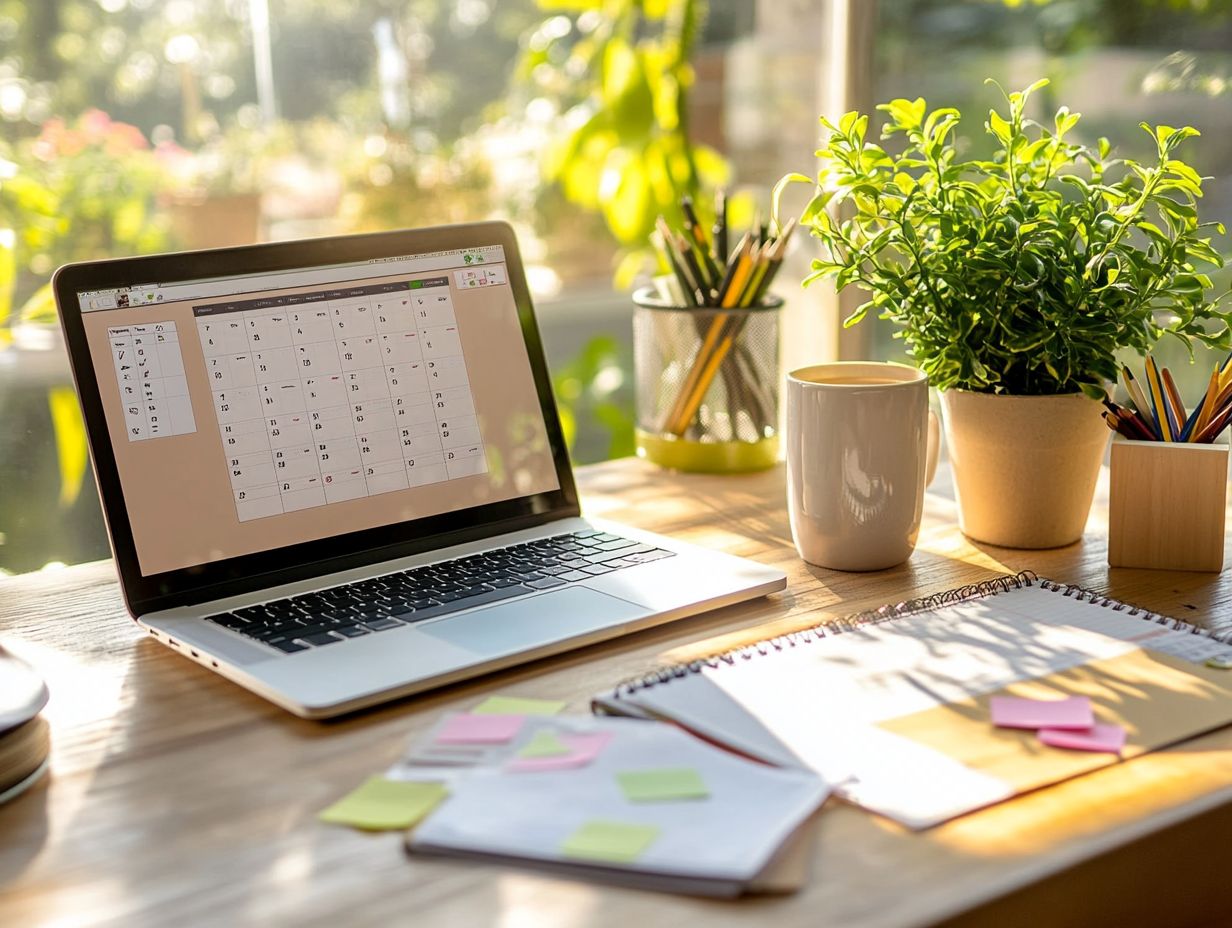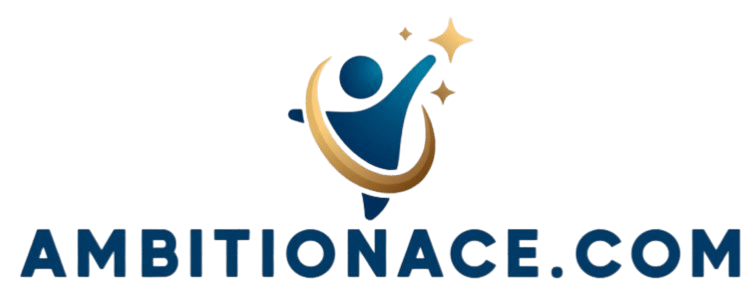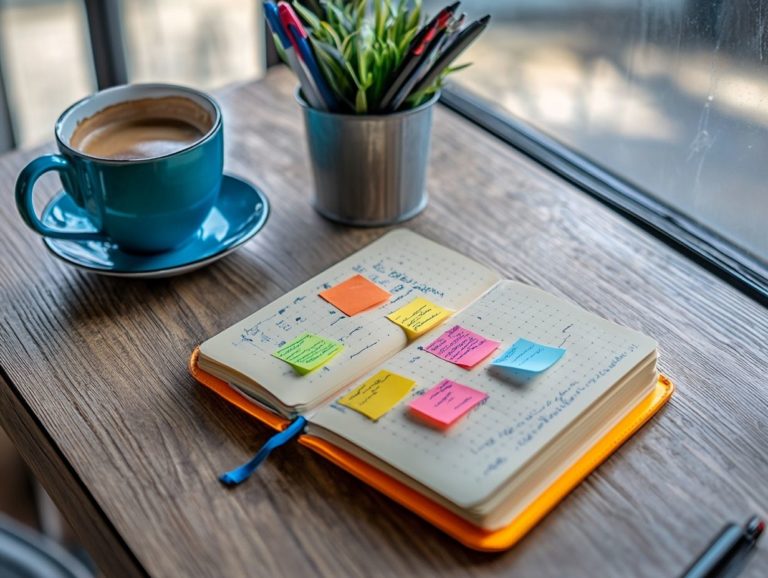10 Ways to Stay Organized and Productive
Staying organized is essential for elevating your productivity, whether in your professional life or day-to-day activities. With an endless array of tasks demanding your focus, mastering the art of organization can truly revolutionize your routine.
Consider implementing ten effective strategies to streamline your day, such as crafting daily to-do lists, leveraging planners, and reducing distractions.
Delve into the advantages of maintaining a tidy workspace, harnessing the power of technology, and recognizing the significance of setting realistic goals.
Discover how to become your most organized and productive self today!
Contents
- Key Takeaways:
- 1. Create a Daily To-Do List
- 2. Use a Calendar or Planner
- 3. Set Realistic Goals
- 4. Prioritize Tasks
- 5. Minimize Distractions
- 6. Delegate Tasks
- 7. Schedule Breaks
- 8. Keep Your Workspace Clean and Organized
- 9. Use Technology to Your Advantage
- 10. Take Care of Your Mental and Physical Health
- How Can Being Organized Improve Productivity?
- Frequently Asked Questions
Key Takeaways:

- Creating a daily to-do list helps you stay on track and prioritize tasks effectively.
- Using a calendar or planner allows you to plan and schedule tasks in advance, reducing stress and increasing productivity.
- Setting realistic goals helps you stay motivated and focused on achieving your tasks.
1. Create a Daily To-Do List
Creating a daily to-do list is crucial for mastering time management and boosting productivity in your workplace. It allows you to break down your tasks into manageable, actionable items. This gives you a sense of control and accomplishment as you navigate through your day.
You have a range of methods at your disposal for crafting these lists, from the simple use of paper notebooks to easy-to-use digital apps that sync seamlessly across devices. This flexibility makes it effortless to track your tasks while on the move.
Digital tools come packed with features like reminders and collaborative options, enhancing communication among your team members. The Eisenhower Matrix helps you decide which tasks to focus on by sorting them into categories based on urgency and importance. The Pomodoro Technique is a time management method that uses short work intervals followed by breaks.
To take ownership of your daily priorities, consider setting specific deadlines and reflecting on your progress at the end of the day. This practice ensures that you stay aligned with your goals and continue to move forward effectively.
2. Use a Calendar or Planner
Utilizing a calendar or planner can significantly enhance your time management and productivity. It allows you to organize tasks, set realistic deadlines, and maintain a schedule that promotes a healthy work-life balance.
With many options available today, from traditional paper planners to advanced digital solutions like Google Calendar and various productivity apps, you can select the format that best aligns with your lifestyle. Digital calendars often come with handy reminders and sharing capabilities, making it easier for you to coordinate with colleagues or family members.
Integrating scheduling into your daily routine helps you establish and track both personal and professional goals. This structured approach not only helps you prioritize your commitments more clearly but also fosters a harmonious integration of your work and home life, ensuring that neither area gets neglected.
3. Set Realistic Goals
Setting realistic goals is essential for maintaining productivity and alleviating stress. It gives you the power to focus on achievable project deliverables while fostering effective communication among team members.
By embracing SMART goals Specific, Measurable, Achievable, Relevant, and Time-bound you can navigate tasks and meet deadlines with clarity. For example, a short-term goal like “completing the monthly sales report by Friday” is both specific and time-bound, ensuring the team knows exactly what is expected and by when. Conversely, a long-term objective such as “increasing client retention rates by 15% over the next year” provides a measurable target that aligns with ongoing strategies.
Implementing these principles not only streamlines workflows but also enhances accountability, as everyone understands their roles within the broader project timeline.
4. Prioritize Tasks

Prioritizing tasks is important for boosting your productivity while managing deadlines to avoid burnout. It helps you identify which tasks need your immediate attention and which can be scheduled for later.
One popular method to consider is the Eisenhower matrix, a simple tool to help you decide what to do first. This tool categorizes tasks based on urgency and importance, enabling you to direct your efforts strategically.
You can also use task assignment techniques that match workloads with individual strengths. This approach can significantly enhance overall efficiency.
However, none of these methods will reach their full potential without strong communication within your team. Clear dialogues about priorities and deadlines are crucial for keeping everyone accountable and aware of their responsibilities.
This collaborative approach fosters transparency and builds a supportive environment where you and your team members feel empowered to contribute effectively.
5. Minimize Distractions
Minimizing distractions in the workplace is essential for maintaining your productivity and focus. It allows you to immerse yourself in tasks and utilize digital tools and automated tools to streamline your workflow.
In today s fast-paced environment, interruptions can come in various forms constant notifications, overflowing emails, casual chats, and even background noise. Setting clear boundaries, like establishing designated quiet hours or using noise-canceling headphones, can cultivate a more conducive atmosphere for concentration.
Using project management applications can help you organize tasks efficiently. Additionally, instant messaging platforms can facilitate clear communication, minimizing misunderstandings. By proactively managing distractions and fostering a culture of open dialogue, you and your team can collaborate more effectively and significantly elevate productivity.
6. Delegate Tasks
Delegating tasks is an essential skill that boosts team collaboration and productivity. It allows you to focus on your strengths while maintaining efficient project management.
When you share responsibilities, your team members feel a sense of ownership over their contributions. This increases their motivation and commitment to the project. This approach creates a cohesive work environment and sparks innovation and problem-solving by bringing diverse perspectives to the table.
To delegate effectively, assess each team member s strengths and weaknesses and assign tasks that align with their skill sets. Clear communication regarding expectations and deadlines, along with providing necessary resources and support, can greatly enhance your delegation efforts.
7. Schedule Breaks
Scheduling regular breaks is essential to prevent burnout and maintain productivity. Taking these moments allows you to recharge, helping you return to your tasks with renewed focus and energy key for achieving a healthier work-life balance.
Incorporating structured techniques like the Pomodoro method can enhance your efficiency. By working in focused intervals, typically 25 minutes of dedicated attention followed by a 5-minute pause, you cultivate a rhythm that encourages deep concentration.
Longer breaks for rest after several cycles can also improve focus and creativity. These strategic pauses sharpen your mental clarity and rejuvenate your creativity, helping you sustain high levels of output throughout the day.
8. Keep Your Workspace Clean and Organized

Maintaining a clean and organized workspace is crucial for boosting your productivity. It helps create an environment that promotes creativity. Reducing clutter and distractions enhances your ability to focus and work efficiently.
An orderly setting aids in concentration and ignites innovative thinking. Elevate your workspace by organizing files into easy-to-access folders and using digital tools for a virtual decluttering experience.
Regularly sift through emails and eliminate unnecessary files to create a clearer mental landscape. A serene environment reduces stress levels, enabling you to tackle tasks with renewed energy and focus. This ultimately leads to enhanced output and imaginative solutions.
9. Use Technology to Your Advantage
Don’t wait leverage technology to significantly elevate productivity in the workplace. Using digital tools, productivity apps, and automation can streamline keeping track of your projects and managing tasks.
Consider tools like Asana, which has a user-friendly interface for task assignments and project timelines. This helps your team stay organized and focused. Meanwhile, ProofHub serves as a comprehensive platform for managing deadlines, collaborating in real-time, and centralizing all project-related documents to ensure alignment.
RescueTime is another valuable tool that helps you identify productivity patterns by tracking how you spend your time. This insight allows you to make informed adjustments.
Integrating these technologies fosters collaboration, minimizes bottlenecks, and helps you achieve your project goals with greater efficiency.
10. Take Care of Your Mental and Physical Health
Prioritize your mental and physical health to boost productivity and prevent burnout. This balance allows you to perform at your best.
In today s demanding work environment, prioritizing well-being is essential for long-term success. Implement strategies like regular mindfulness practices to significantly enhance focus and reduce anxiety, making it easier to navigate workplace challenges.
Exercise boosts your energy and reduces stress make it part of your routine! Maintaining a balanced diet can improve your mood and cognitive function. Together, these approaches create a healthier atmosphere, empowering you to thrive both personally and professionally.
How Can Being Organized Improve Productivity?
Being organized is key to elevating your productivity. It promotes essential organizational skills that empower you to manage your time effectively and prioritize tasks. For additional strategies, consider exploring top 10 productivity hacks you should try to communicate seamlessly within your teams.
When you and your team members focus on task prioritization, you concentrate on high-impact activities that align with your overarching goals. This approach alleviates stress and minimizes confusion. Clear communication fosters a collaborative environment, building trust and accountability.
This synergy enhances individual performance while propelling the entire team’s workflow, leading to quicker response times and greater adaptability to shifting demands.
As a result, your organization s capacity to swiftly tackle challenges increases, resulting in heightened efficiency and a more engaged workforce.
What Are the Benefits of Using a Digital Calendar or Planner?

Utilizing a digital calendar or planner brings a wealth of benefits for your productivity and time management. These tools allow you to seamlessly integrate goal setting and scheduling into your everyday life.
They offer exceptional accessibility, enabling you to check your schedule from various devices whether it s your smartphone, tablet, or computer. You can remain organized no matter where you find yourself. Digital planning tools often include built-in reminders that notify you of upcoming tasks or appointments, significantly reducing the chance of overlooking important deadlines.
If you re balancing work projects with personal commitments, you can integrate your digital planner with other applications like task managers or email. This boosts your efficiency and promotes a more organized lifestyle. These connections streamline your daily activities and enhance collaboration within teams, ensuring that everyone stays aligned on project timelines and responsibilities.
How Can Delegating Tasks Improve Productivity?
Delegating tasks effectively can elevate your productivity by fostering collaboration within your team and optimizing project management for both efficiency and success.
When you entrust individuals with responsibilities that play to their strengths, you speed up task completion and cultivate a strong sense of ownership and accountability. For example, a project manager assigning complex data analysis to a team member who excels in research allows others to concentrate on strategic planning. This builds trust among team members and enhances the overall workflow, as everyone feels valued and recognized for their unique contributions.
Effective delegation promotes open communication, which is crucial for identifying potential roadblocks early on. This keeps the team aligned and projects moving fast toward common objectives, propelling your projects forward with clarity and purpose.
What Are Some Tips for Maintaining a Clean and Organized Workspace?
To keep your workspace clean and organized, take charge and be proactive. Effective file management and regular virtual decluttering can enhance both productivity and mental clarity, helping you implement 5 ways to stay focused on your priorities.
This applies to both physical items like desk supplies and paperwork, as well as your digital platforms. Organizing your emails and files can significantly reduce stress and create a more manageable workflow.
By implementing a systematic filing system and using tools that prioritize your tasks, you can streamline your daily activities. For further improvement, consider exploring ways to enhance your time management skills. Creating designated zones for specific tasks helps minimize distractions and enhances your focus.
A tidy environment fosters creativity, allowing your mind to engage more freely with ideas and solutions. This boosts performance and leads to greater satisfaction in your work.
How Can Technology Help with Organization and Productivity?
Technology plays a crucial role in enhancing your organization and productivity. It offers a suite of productivity apps and automation tools that simplify project management and streamline task execution.
Imagine using intuitive project management software that enables your team to collaborate seamlessly in real-time or task management tools that empower you to prioritize your workload effectively. These solutions boast user-friendly interfaces and robust features tailored to your needs. For instance, Gantt charts (visual timelines for project scheduling) and Kanban boards (visual task lists) provide snapshots of your tasks, making it effortless to track progress and meet deadlines.
Automation tools handle reminders and notifications, freeing up precious time to focus on strategic initiatives instead of getting bogged down in administrative details.
Ultimately, by leveraging these technologies, you can significantly boost your efficiency and ensure that everyone remains aligned toward common goals.
What Are Some Common Productivity Mistakes to Avoid?
Are you making these common productivity mistakes? Avoiding common productivity mistakes is essential for maintaining high efficiency in your workplace. This gives you the power to enhance your time management skills and prioritize tasks effectively.
Recognizing these pitfalls allows you to navigate your workday more smoothly, ensuring that important responsibilities don t slip through the cracks. Cultivating an environment of open communication is equally crucial; misunderstandings can lead to duplicated efforts or missed deadlines. Don t let misunderstandings cost you valuable time cultivate open communication today!
Assessing your workload regularly is essential, allowing you to identify tasks that may be incorrectly taking precedence. A simple method to prioritize tasks based on urgency and importance can help you distinguish between what is urgent and what truly matters, ultimately leading to better productivity outcomes.
Frequently Asked Questions
What are 10 ways to stay organized and productive?
1. Create a to-do list: Write down all your tasks for the day to stay on track.
2. Prioritize tasks: Focus on the most important tasks first to avoid feeling overwhelmed.
3. Set deadlines: Give yourself a specific timeline to complete each task.
4. Declutter your workspace: A clean and organized workspace can help improve productivity.
5. Use a planner or calendar: Keep track of important dates and events to avoid forgetting them.
6. Utilize technology: There are many apps and tools available to help you stay organized and productive, including 7 ways to stay on task and avoid procrastination.
7. Take breaks: It’s important to step away from work and recharge to avoid burnout.
8. Delegate tasks: Don’t hesitate to ask for help or delegate tasks to others when necessary.
9. Stay consistent: Develop a routine and stick to it to maintain organization and productivity.
10. Reflect and adjust: Regularly assess your productivity methods and make adjustments as needed.






